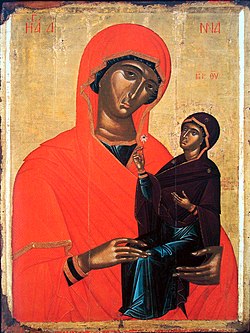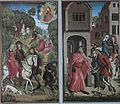Saint Anne
Saint Anne | |
|---|---|
 | |
| Mother of the Virgin, Mystic, Maternal Heroine, Woman of Amram | |
| Born | c. 1st century B.C.E. |
| Venerated in | Christianity Islam Aglipayan Church |
| Feast | July 26 (Western calendar) and July 25 (Eastern calendar) |
| Attributes | Book, door, with Mary, Jesus or Joachim |
| Patronage | carpenters; childless people; equestrians; grandparents; homemakers/housewives; lace makers; lost articles; Fasnia(Tenerife); Mainar; Detroit; miners; mothers; moving house; old-clothes dealers; poverty; pregnancy; seamstresses; stablemen; sterility |
Saint Anne (also Ann or Anna, from Hebrew Hannah חַנָּה, meaning "favor" or "grace") of David's house and line, was the mother of the Virgin Mary and grandmother of Jesus Christ according to Christian and Islamic tradition. English Anne is derived from Greek rendering of her Hebrew name Hannah. Mary's mother is not named in the canonical gospels or the Qur'an, and her name and that of her husband Joachim come only from New Testament apocrypha, of which the Protoevangelium of James, written perhaps around 150, seems to be the earliest that mentions them.
Church tradition
The story bears a similarity to that of the birth of Samuel, whose mother Hannah had also been childless. Although Hanna receives little attention in the Western church prior to the late 12th century,[1] dedications to Hanna in the Eastern church occur as early as the 6th century.[2] In the Eastern Orthodox Churches and Eastern Catholic Churches, she is revered as Hanna. In the Eastern Orthodox tradition, Hanna, is ascribed the title Forbear of God, and both the Birth of Mary and the Dedication of Mary to the Temple are celebrated as two of the Twelve Great Feasts. The Dormition of Hanna is also a minor feast in the Eastern Church. In Protestant tradition it is held that Martin Luther chose to enter religious life as a monk after receiving heavenly aid from St. Anne.
Islamic view of Anne
Anne (Arabic: Hannah) is also a revered woman in Islam and is recognized as a highly spiritual woman as well as the mother of Mary. The daughter of Faqud, Hannah was childless until her old age. She saw a bird feeding its young while sitting in the shade of a tree, which awakened her desire to have children of her own. She prayed for a child and eventually conceived. Her husband, known as Imran in the Qur'an, died before the child was born. Expecting the child to be male, Hannah vowed to dedicate him to isolation and the service in the Temple.[N 1][3][4] However, Hannah bore a daughter instead, and she named her Mary. Her words [N 2] after the birth of Mary reflect her status as a great mystic. Hannah wanted a son, but she realized that the daughter was God's gift to her.[3][4]
Legends
Varying theologians have believed either that Joachim was Anne's only husband or that she was married thrice. Ancient belief, attested to by a sermon of St John Damascene, was that Anne married once. In late medieval times, legend held that Anne was married three times, first to Joachim, then to Clopas and finally to a man named Solomas and that each marriage produced one daughter: Mary, mother of Jesus, Mary of Clopas, and Mary Salomae, respectively.[5] The sister of Saint Hanna was Sobe who was the mother of Saint Elizabeth.
Similarly, in the 4th century and then much later in the 15th century, a belief arose that Mary was born of Anne by virgin birth.[6] Those believers included the 16th century Lutheran mystic Valentine Weigel who claimed Anne conceived Mary by the power of the Holy Spirit. This belief was condemned as an error by the Catholic Church in 1677. Instead, the Church teaches that Mary was conceived in the normal fashion, but that she was miraculously preserved from original sin in order to make her fit to bear Christ. The conception of Mary free from original sin is termed the Immaculate Conception—which is frequently confused with the Virgin Birth or Incarnation of Christ.
In the fifteenth century, the Catholic cleric Johann Eck related in a sermon that St Anne's parents were named Stollanus and Emerentia. The Catholic Encyclopedia (1907) regards this genealogy as spurious.[7]
Anne in art
The iconographic subject of Joachim and Anne The Meeting at the Golden Gate fitted both views, and was a regular component of artistic cycles of the Life of the Virgin. The couple meet at the "Golden Gate" of Jerusalem and embrace. They are aware of Anne's pregnancy, of which they have been separately informed by an archangel. For those believing in the virgin birth of Mary, this moment stood for her conception, and the feast was celebrated on the same day as the Immaculate Conception. Art works representing the Golden Gate and the events leading up to it were influenced by the narrative in the widely read Golden Legend of Jacobus de Voragine. The Birth of Mary, the Presentation of Mary and the Marriage of the Virgin were usual components of cycles of the Life of the Virgin in which Anne is normally shown.
Anne is never shown as present at the Nativity of Christ, but is frequently shown with the infant Christ in various subjects. She is sometimes believed to be depicted in scenes of the Presentation of Jesus at the Temple and the Circumcision of Christ but in the former case this likely reflects a misidentification through confusion with Anna the Prophetess. Anna is described in Luke's Gospel as a holy widow who recognizes Jesus as the Messiah at his Presentation, along with Simeon the Righteous and both frequently appear in artistic depictions of the story. There was a tradition that Anne went (separately) to Egypt and rejoined the Holy Family after their Flight to Egypt. Anne is not seen with the adult Christ, so was regarded as having died during the youth of Jesus.[8] Anne is also shown as the matriarch of the Holy Kinship, the extended family of Jesus, a popular subject in late medieval Germany, some versions of these pictorial and sculptural depictions include Emerentia who was reputed in the 15th Century to be Anne's mother. In modern devotions, Anne and her husband are invoked for protection for the unborn.
Another typical subject has Anne teaching the Virgin Mary how to read (see gallery below).
Patronage
Ann is the patron saint of the following places:[citation needed] Detroit, Michigan;[9] Brittany, France; Castelbuono, Sicily, Italy; Quebec and the Mi'kmaq peoples of Canada; Fasnia; Adjuntas, Puerto Rico; Norwich, Connecticut; Santa Ana Pueblo; Santa Ana, El Salvador; Jucuarán, El Salvador; Seama, New Mexico; Taos, New Mexico; Chiclana de la Frontera, Spain; Marsaskala; Tudela, Navarre; Philippines, where the National Shine of St. Anne is in the poblacion of Hagonoy, Bulacan,Santa Ana, Taguig City; Santana, São Paulo, Brazil; Saint Anne, Illinois; and places in Malaysia and South Vietnam. She is also the patron saint of horseback riders, housewives, grandmothers, cabinet makers, unmarried women, women in labor and miners.
Düren has been the main place of pilgrimage for Anne since 1506, when Pope Julius II decreed that her relics should be kept there.
Cities
The city of Santa Ana, California was named in her honour. Many schools and places of worship are named after St Anne, the most famous being a parish church and primary school in Caversham, Reading.
Gallery
-
Coptic, 8th century
-
German, 15th century. Anne holds Mary and Christ
-
German, 15th century, Legends of St Anne
-
Presentation of Mary at the Temple
-
German, 16th century. Relief of the St. Annes Head, Annakirche Dueren
-
Annunciation to Anne mosaic, 12th century, Chora Church, Istanbul
-
An Anna Selbdritt in the Cathedral Museum of the Church of Santiago Compostela
-
A Belgian Anna Selbdritt (labeled Ste Anne Trinitaire by the museum)
-
A Spanish Anna Selbdritt influenced ultimately by Greek "Hodegetria" icons
-
An Anna Selbdritt from Oaxaca, Mexico
-
St. Anne Teaching the Virgin to Read, Church of San Giuseppe alla Lungara, Rome
-
St. Anne Teaching the Virgin to Read, Church of St Andrew by the Wardrobe, London
-
St. Anne Teaching the Virgin to Read, Parish church of St.Ulrich in Ulrichsberg, 1722
See also
Notes
- ^ "O my Lord! I do dedicate into Thee what is in my womb for Thy special service: So accept this of me: For Thou hearest and knowest all things." (Qur'an 3:35).
- ^ When Mary was delivered, she said, "O my Lord! Behold! I am delivered of a female child!" - and God knew best what she brought forth - "And nowise is the mal like the female."(Qur'an 3:36)
References
- ^ Nixon, Virginia (2004). Mary's Mother: Saint Anne in Late Medieval Europe. University Park, PA: The Pennsylvania State University Press. pp. 12–14. ISBN 978-0-271-02466-0.
{{cite book}}:|access-date=requires|url=(help) - ^ Procopius' Buildings, Volume I, Chapter 11-12
- ^ a b Wheeler, Brannon M. (2002). Prophets in the Quran: an introduction to the Quran and Muslim exegesis. Continuum International Publishing Group. ISBN 0-8264-4957-3.
{{cite book}}:|access-date=requires|url=(help) - ^ a b Da Costa, Yusuf (2002). The Honor of Women in Islam. ISCA. ISBN 1-930409-06-0.
{{cite book}}:|access-date=requires|url=(help) - ^ Golden Legend II.131
- ^ Herbermann, Charles, ed. (1913). . Catholic Encyclopedia. New York: Robert Appleton Company.
- ^ Frederick G. Holweck 1907. Catholic Encyclopedia article: St Anne "The renowned Father John of Eck of Ingolstadt, in a sermon on St. Anne (published at Paris in 1579), pretends to know even the names of the parents St. Anne. He calls them Stollanus and Emerentia. He says that St. Anne was born after Stollanus and Emerentia had been childless for twenty years"
- ^ Some writers gave her age at death, as part of a general family chronology, but no generally accepted tradition developed on this point, even during the Middle Ages.
- ^ http://www.aodonline.org/AODOnline/News+++Publications+2203/Press+Releases+2303/2011+18610/StAnne.htm
External links
- Saint Anne at Patron Saints Index
- Brief American Catholic article on "Sts. Joachim and Ann"
- "Anna, Grandmother of Jesus" by Claire Heartsong
- St. Anne page at Christian Iconography
- "Here Followeth the Nativity of Our Blessed Lady" from the Caxton translation of the Golden Legend
- The Protevangelium of James
- The Gospel of Pseudo-Matthew











